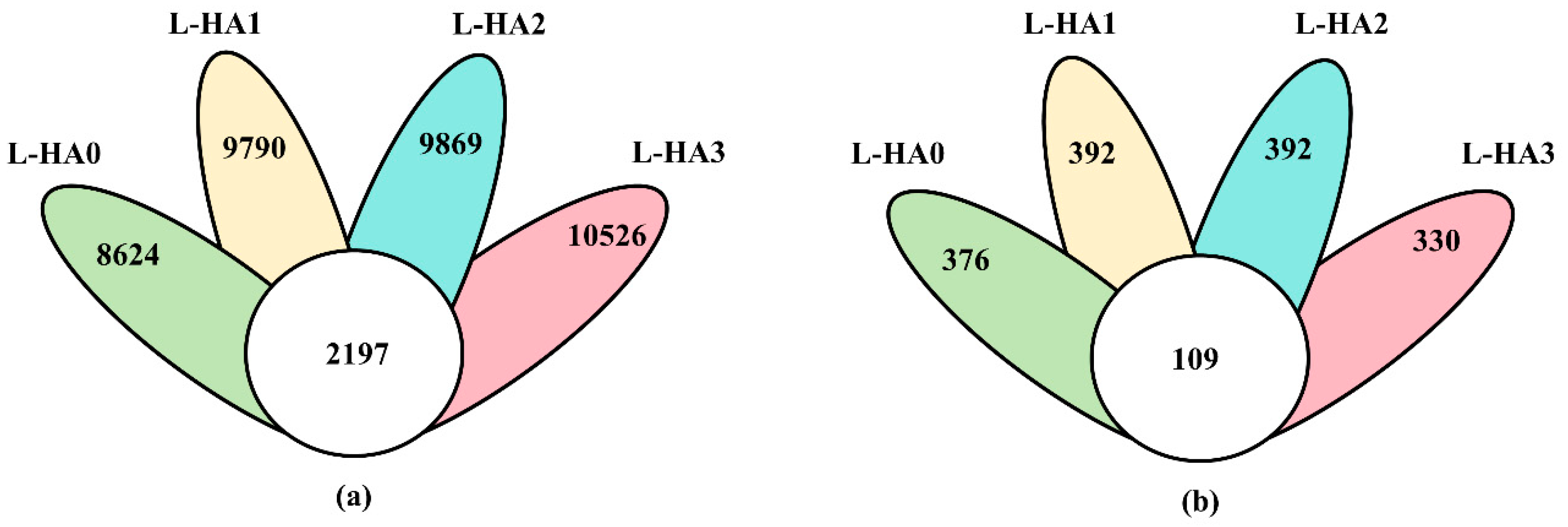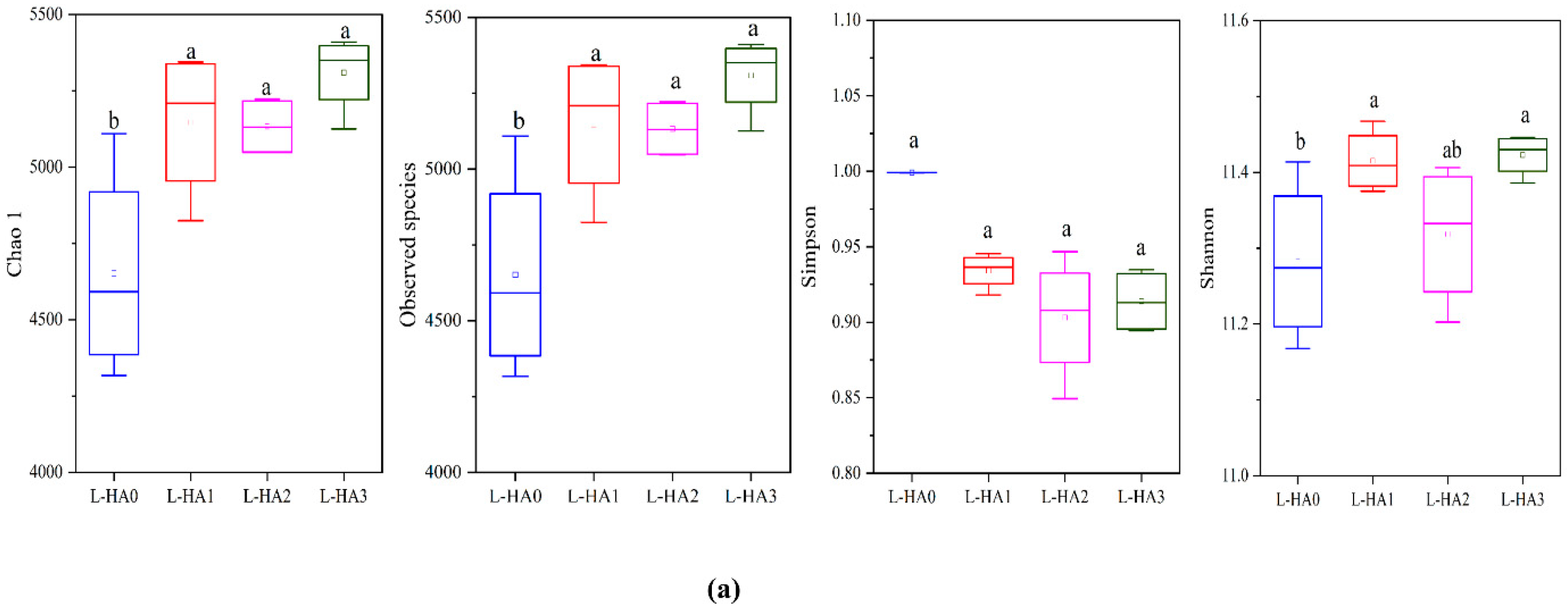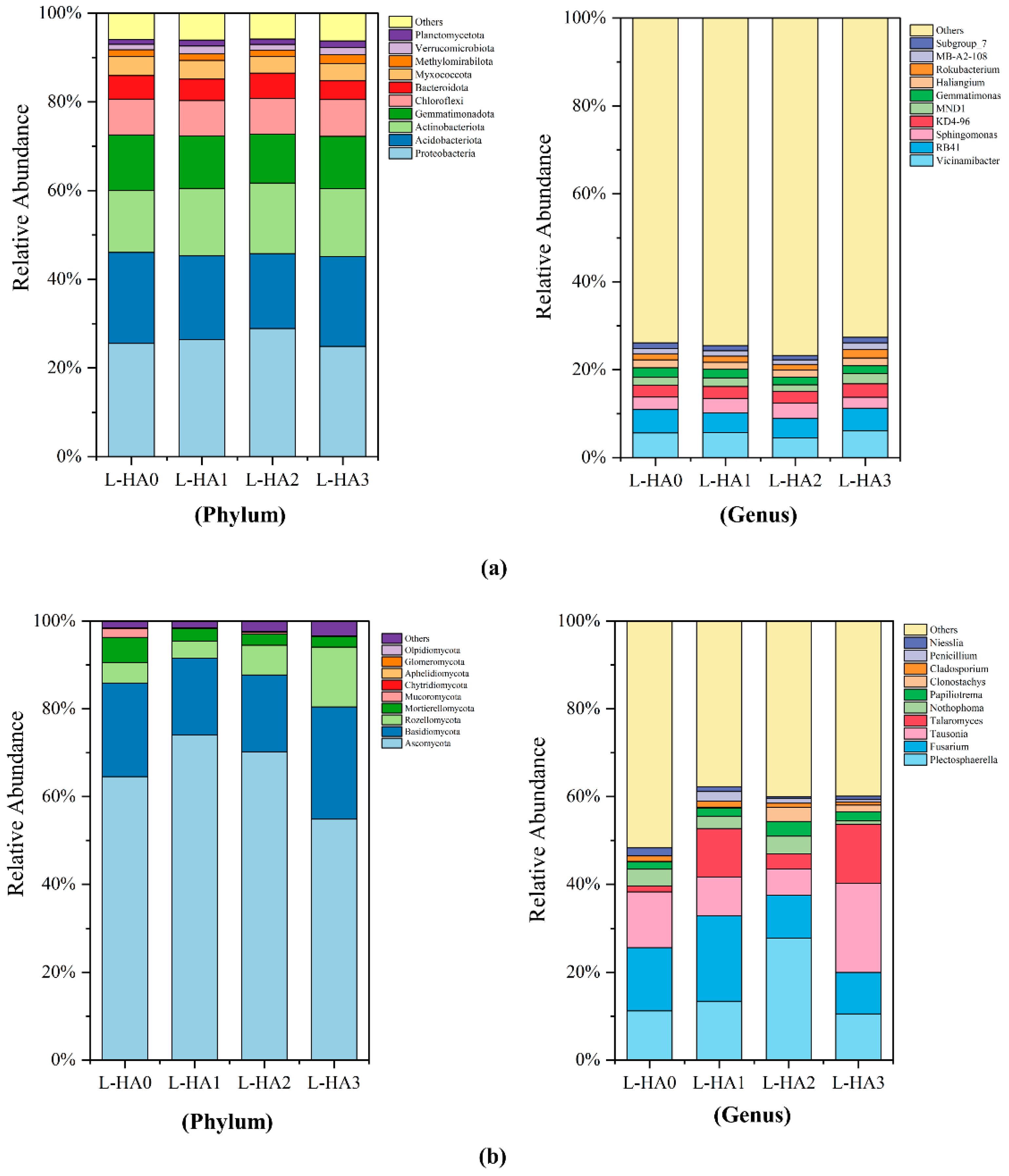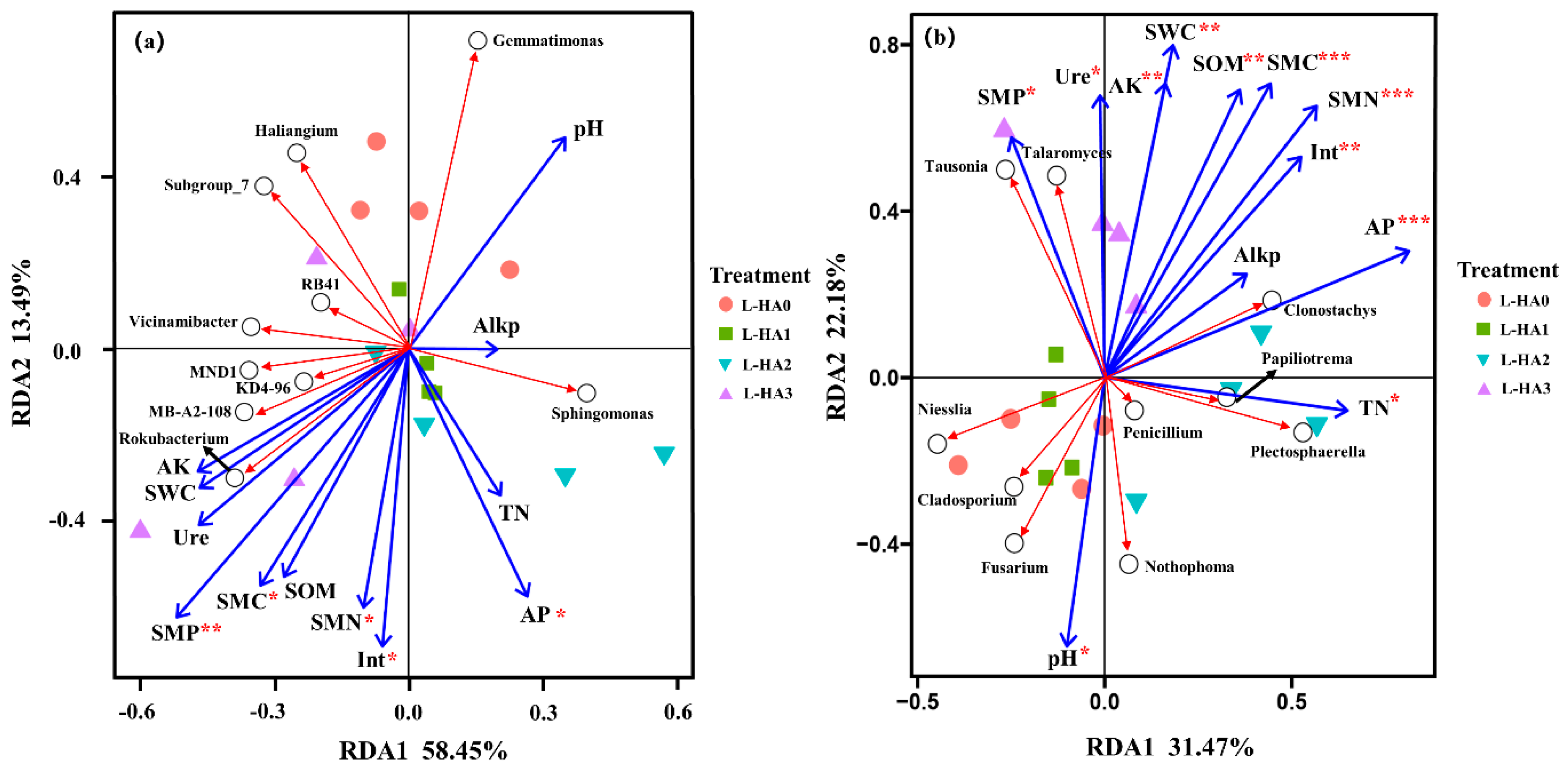Impact of a Single Lignite Humic Acid Application on Soil Properties and Microbial Dynamics in Aeolian Sandy Soils: A Fourth-Year Study in Semi-Arid Inner Mongolia
Abstract
1. Introduction
2. Materials and Methods
2.1. Study Sites
2.2. Lignite Humic Acid and Field Experiment
2.3. Soil Sampling and Analysis
2.4. DNA Extraction and Sequencing
2.5. Bioinformatic Analysis
2.6. Statistical Analysis
3. Results
3.1. Soil Properties
3.2. Soil Bacterial and Fungal Community Diversity
3.3. Bacterial and Fungal Community Composition
3.4. The Linkage Between Soil Microbial Community Structure and Environmental Factors
4. Discussion
4.1. Changes in Soil Properties with L-HA Addition
4.2. Response of Soil Bacterial Community Composition to L-HA Addition
4.3. Response of Soil Fungal Community Composition to L-HA Addition
5. Conclusions
Supplementary Materials
Author Contributions
Funding
Data Availability Statement
Conflicts of Interest
References
- Wirsenius, S.; Azar, C.; Berndes, G. How much land is needed for global food production under scenarios of dietary changes and livestock productivity increases in 2030? Agric. Syst. 2010, 103, 621–638. [Google Scholar] [CrossRef]
- Food and Agricultural Organization. FAO Statistical Yearbook 2020, World Food and Agriculture, 3rd ed.; Food and Agriculture Organization of the United Nations: Rome, Italy, 2022; p. 2. [Google Scholar]
- Huang, J.; Hartemink, A.E. Soil and environmental issues in sandy soils. Earth Sci. Rev. 2020, 208, 103295. [Google Scholar] [CrossRef]
- Bockheim, J.G. Sandy Soils of the World: Taxonomy, Geography, and Soil Conditions. In Sandy Soils. Progress in Soil Science; Hartemink, A.E., Huang, J., Eds.; Springer: Cham, Switzerland, 2023. [Google Scholar] [CrossRef]
- Zhou, L.; Monreal, C.M.; Xu, S.; Mclaughlin, N.B.; Zhang, H.; Hao, G.; Liu, J. Effect of bentonite-humic acid application on the improvement of soil structure and maize yield in a sandy soil of a semi-arid region. Geoderma 2019, 338, 269–280. [Google Scholar] [CrossRef]
- Scotti, R.; Bonanomi, G.; Scelza, R.; Zoina, A.; Rao, M.A. Organic amendments as sustainable tool to recovery fertility in intensive agricultural systems. J. Soil Sci. Plant Nutr. 2015, 15, 333–352. [Google Scholar] [CrossRef]
- Senn, T.L.; Kingman, A.R. A review of humus and humic acids. Res. Ser. 1973, 145, 1–5. [Google Scholar]
- Yonebayashi, K.; Hattori, T. Chemical and biological studies on environmental humic acids: I. Composition of elemental and functional groups of humic acids. Soil. Sci. Plant Nutr. 1988, 34, 571–584. [Google Scholar] [CrossRef]
- Tan, K.H.; Nopamornbodi, V. Effect of different levels of humic acids on nutrient content and growth of corn (Zea mays L.). Plant Soil 1979, 51, 283–287. [Google Scholar] [CrossRef]
- Karakurt, Y.; Unlu, H.; Unlu, H.; Padem, H. The influence of foliar and soil fertilization of humic acid on yield and quality of pepper. Acta Agric. Scand. Sect. B–Soil Plant Sci. 2009, 59, 233–237. [Google Scholar] [CrossRef]
- Nardi, S.; Pizzeghello, D.; Muscolo, A.; Vianello, A. Physiological effects of humic substances on higher plants. Soil Biol. Biochem. 2002, 34, 1527–1536. [Google Scholar] [CrossRef]
- Skujins, J.; Richardson, B.Z. Humic matter enrichment in reclaimed soils under semiarid conditions. Geomicrobiol. J. 1985, 4, 299–311. [Google Scholar] [CrossRef]
- Zhou, S.M.; Zhang, M.; Zhang, K.K.; Yang, X.W.; He, D.X.; Yin, J.; Wang, C.Y. Effects of reduced nitrogen and suitable soil moisture on wheat (Triticum aestivum L.) rhizosphere soil microbiological, biochemical properties and yield in the Huanghuai Plain, China. J. Integr. Agric. 2020, 19, 234–250. [Google Scholar] [CrossRef]
- Biswas, T.; Kole, S.C. Soil Organic Matter and Microbial Role in Plant Productivity and Soil Fertility. In Advances in Soil Microbiology: Recent Trends and Future Prospects, 1st ed.; Adhya, T., Mishra, B., Annapurna, K., Verma, D., Kumar, U., Eds.; Springer: Singapore, 2017; Volume 4, pp. 219–238. [Google Scholar] [CrossRef]
- Gomes, S.I.F.; Merckx, V.S.F.T.; Kehl, J.; Gebauer, G. Mycoheterotrophic plants living on arbuscular mycorrhizal fungi are generally enriched in 13C, 15N and 2H isotopes. J. Ecol. 2020, 108, 1250–1261. [Google Scholar] [CrossRef]
- Li, Q.; Bao, X.; Lu, C.; Zhang, X.; Zhu, J.; Jiang, Y.; Liang, W. Soil microbial food web responses to free-air ozone enrichment can depend on the ozone-tolerance of wheat cultivars. Soil Biol. Biochem. 2012, 47, 27–35. [Google Scholar] [CrossRef]
- Tan, Z.X.; Lin, C.S.K.; Ji, X.Y.; Rainey, T.J. Returning biochar to fields: A review. Appl. Soil Ecol. 2017, 116, 1–11. [Google Scholar] [CrossRef]
- Li, Y.; Fang, F.; Wei, J.; Wu, X.; Cui, R.; Li, G.; Zheng, F.; Tan, D. Humic acid fertilizer improved soil properties and soil microbial diversity of continuous cropping peanut: A three-year experiment. Sci. Rep. 2019, 9, 12014. [Google Scholar] [CrossRef] [PubMed]
- Griffiths, B.S.; Bonkowski, M.; Roy, J.; Ritz, K. Functional stability: Substrate utilisation and biological indicators of soils following environmental impacts. Appl. Soil Ecol. 2001, 16, 49–61. [Google Scholar] [CrossRef]
- Rekaby, S.A.; AL-Huqail, A.A.; Gebreel, M.; Alotaibi, S.S.; Ghoneim, A.M. Compost and humic acid mitigate the salinity stress on quinoa (Chenopodium quinoa Willd L.) and improve some sandy soil properties. J. Soil Sci. Plant Nutr. 2023, 23, 2651–2661. [Google Scholar] [CrossRef]
- Al-Fraihat, A.H.; Al-Tabbal, J.A.; Abu-Darwish, M.S.; Alhrout, H.H.; Hasan, H.S. Response of onion (Allium cepa) crop to foliar application of humic acid under rain-fed conditions. Int. J. Agric. Biol. 2018, 20, 1235–1241. [Google Scholar]
- Meng, H.; Zhou, H.; Wang, L.; Zhang, X.; Liu, W.; Zhao, Y.; Dong, B.; Yi, W.; Zhao, Y.; Wang, D. Occurrence and Distribution of Rhinoncus sibiricus (Coleoptera: Curculionoidea) and Its Preference for two buckwheat species in China. J. Insect Sci. 2019, 19, 4. [Google Scholar] [CrossRef]
- Zhou, L.; Chu, J.; Zhang, Y.; Wang, Q.; Ye, Y.; Zhao, B. Effect of Biochar Application on the Improvement of Soil Properties and Buckwheat (Fagopyrum esculentum Moench) Yield on Two Contrasting Soil Types in a Semi-Arid Region of Inner Mongolia. Agronomy 2024, 14, 1137. [Google Scholar] [CrossRef]
- Fan, K.; Delgado-Baquerizo, M.; Zhu, Y.; Chu, H. Crop production correlates with soil multitrophic communities at the large spatial scale. Soil Biol. Biochem. 2020, 151, 108047. [Google Scholar] [CrossRef]
- Qiu, H.; Liu, J.; Boorboori, M.R.; Chen, S.; Ma, X.; Cheng, P.; Zhang, H. Effect of biochar application rate on changes in soil labile organic carbon fractions and the association between bacterial community assembly and carbon metabolism with time. Sci. Total Environ. 2023, 855, 158876. [Google Scholar] [CrossRef] [PubMed]
- Bao, S.D. Soil Agricultural Chemical Analysis, 3rd ed.; China Agricultural Press: Beijing, China, 2000; pp. 26–48. [Google Scholar]
- Olsen, S.; Sommers, L.; Page, A. Methods of Soil Analysis: Part 2 Chemical and Microbiological Properties of Phosphorus; ASA Monograph 9; Wiley: New York, NY, USA, 1982; pp. 403–430. [Google Scholar]
- Helmke, P.A.; Sparks, D.L. Lithium, Sodium, Potassium, Rubidium, and Cesium. In Methods of Soil Analysis: Part 3 Book Series No.5. Soil Science Society of America; Madison, Ed.; Wiley: New York, NY, USA, 1996; pp. 551–573. [Google Scholar]
- Brookes, P.; Landman, A.; Pruden, G.; Jenkinson, D. Chloroform fumigation and the release of soil nitrogen: A rapid direct extraction method to measure microbial biomass nitrogen in soil. Soil Boil. Biochem. 1985, 17, 837–842. [Google Scholar] [CrossRef]
- Brookes, P.; Powlson, D.; Jenkinson, D. Measurement of microbial biomass phosphorus in soil. Soil Boil. Biochem. 1982, 14, 319–329. [Google Scholar] [CrossRef]
- Cui, Y.; Fang, L.; Guo, X.; Wang, X.; Wang, Y.; Li, P.; Zhang, Y.; Zhang, X. Responses of soil microbial communities to nutrient limitation in the desert grassland ecological transition zone. Sci. Total Environ. 2018, 642, 45–55. [Google Scholar] [CrossRef]
- Zhou, L.; Xu, S.T.; Monreal, C.M.; Mclaughlin, N.B.; Zhao, B.P.; Liu, J.H.; Hao, G.C. Bentonite-humic acid improves soil organic carbon, microbial biomass, enzyme activities and grain quality in a sandy soil cropped to maize (Zea mays L.) in a semi-arid region. J. Integr. Agric. 2022, 21, 208–221. [Google Scholar] [CrossRef]
- Guan, S.Y.; Zhang, D.S.; Zhang, Z.M. Methods of Soil Enzyme Activities Analysis; Agriculture press: Beijing, China, 1991; pp. 274–297. [Google Scholar]
- Yu, Y.; Lee, C.; Kim, J.; Hwang, S. Group-specifc primer and probe sets to detect methanogenic communities using quantitative real-time polymerase chain reaction. Biotechnol. Bioeng. 2005, 89, 670–679. [Google Scholar] [CrossRef]
- Degnan, P.H.; Ochman, H. Illumina-based analysis of microbial community diversity. ISME J. 2011, 6, 183–194. [Google Scholar] [CrossRef]
- Callahan, B.J.; Mcmurdie, P.J.; Rosen, M.J.; Han, A.W.; Johnson, A.J.; Holmes, S.P. Dada2: High-resolution sample inference from illumina amplicon data. Nat. Methods 2016, 13, 581–583. [Google Scholar] [CrossRef]
- Katoh, K.; Misawa, K.; Kuma, K.; Miyata, T. MAFFT: A novel method for rapid multiple sequence alignment based on fast Fourier transform. Nucleic Acids Res. 2002, 30, 3059–3066. [Google Scholar] [CrossRef]
- Wang, Y.F.; Chen, P.; Wang, F.H.; Han, W.X.; Qiao, M.; Dong, W.X.; Hu, C.S.; Zhu, D.; Chu, H.Y.; Zhu, Y.G. The ecological clusters of soil organisms drive the ecosystem multifunctionality under long-term fertilization. Environ. Int. 2022, 161, 107133. [Google Scholar] [CrossRef] [PubMed]
- Zheng, W.; Zhao, Z.; Gong, Q.; Zhai, B.; Li, Z. Responses of fungal–bacterial community and network to organic inputs vary among different spatial habitats in soil. Soil Biol. Biochem. 2018, 125, 54–63. [Google Scholar] [CrossRef]
- Zaura, E.; Keijser, B.J.; Huse, S.M.; Crielaard, W. Defining the healthy “core microbiome” of oral microbial communities. BMC Microbiol. 2009, 9, 259. [Google Scholar] [CrossRef] [PubMed]
- Chao, A. Nonparametric estimation of the number of classes in a population. Scand. J. Stat. 1984, 11, 265–270. [Google Scholar]
- Shannon, C.E. Claude Elwood Shannon. Bell Syst. Tech. J. 1948, 27, 379–423. [Google Scholar] [CrossRef]
- Simpson, E.H. Measurement of diversity. Nature 1949, 163, 688. [Google Scholar] [CrossRef]
- Anderson, M.J. Permutational Multivariate Analysis of Variance (PERMANOVA); John Wiley & Sons, Ltd.: Hoboken, NJ, USA, 2017; pp. 1–15. [Google Scholar] [CrossRef]
- Legendre, P.; De Cáceres, M. Beta diversity as the variance of community data: Dissimilarity coefficients and partitioning. Ecol. Lett. 2013, 16, 951–963. [Google Scholar] [CrossRef]
- Legendre, P.; Legendre, L. Principal Component Analysis and Redundancy Analysis. In Analysing Ecological Data, Statistics for Biology and Health; Springer: New York, NY, USA, 2007; pp. 425–500. [Google Scholar] [CrossRef]
- Xu, J.; Mohamed, E.; Li, Q.; Lu, T.; Yu, H.; Jiang, W. Effect of humic acid addition on buffering capacity and nutrient storage capacity of soilless substrates. Front. Plant Sci. 2021, 12, 644229. [Google Scholar] [CrossRef]
- Sharif, M.; Khattak, R.A.; Sarir, M.S. Effect of different levels of lignitic coal derived humic acid on growth of maize plants. Commun. Soil Sci. Plant Anal. 2002, 33, 3567–3580. [Google Scholar] [CrossRef]
- Roudgarnejad, S.; Samdeliri, M.; Mirkalaei, A.M.; Moghaddam, M.N. The role of humic acid application on quantitative and qualitative traits of faba bean (Vicia faba L.). Gesunde Pflanz. 2021, 73, 603–611. [Google Scholar] [CrossRef]
- Ni, H.; Zhao, J.; Yang, Z. Effects of compound fertilizer decrement and water-soluble humic acid fertilizer application on soil properties, bacterial community structure, and shoot yield in Lei Bamboo (Phyllostachys praecox) plantations in subtropical China. Forests 2024, 15, 400. [Google Scholar] [CrossRef]
- Abiven, S.; Menasseri, S.; Chenu, C. The effects of organic inputs over time on soil aggregate stability—A literature analysis. Soil Biol. Biochem. 2009, 41, 1–12. [Google Scholar] [CrossRef]
- Gümüş, İ.; Şeker, C. Influence of humic acid applications on soil physicochemical properties. Solid Earth 2015, 7, 2481–2500. [Google Scholar] [CrossRef]
- Hueso, S.; García, C.; Hernández, T. Severe drought conditions modify the microbial community structure, size and activity in amended and unamended soils. Soil Biol. Biochem. 2012, 50, 167–173. [Google Scholar] [CrossRef]
- Liu, L.L.; Shi, C.X.; Jiang, T.B.; Yu, H.J.; Liu, F.J. Microbial and enzyme activity in response to humic acid in soil with a ginger crop. Acta Ecol. Sin. 2009, 29, 6136–6141. [Google Scholar] [CrossRef]
- Fierer, N. Embracing the unknown: Disentangling the complexities of the soil microbiome. Nat. Rev. Microbiol. 2017, 15, 579–590. [Google Scholar] [CrossRef]
- Fan, S.; Zuo, J.; Dong, H. Changes in soil properties and bacterial community composition with biochar amendment after six years. Agronomy 2020, 10, 746. [Google Scholar] [CrossRef]
- Ai, S.; Meng, X.; Zhang, Z.; Li, R.; Teng, W.; Cheng, K.; Yang, F. Artificial humic acid regulates the impact of fungal community on soil macroaggregates formation. Chemosphere 2023, 332, 138822. [Google Scholar] [CrossRef]
- Cole, E.J.; Zandvakili, O.R.; Blanchard, J.; Xing, B.; Hashemi, M.; Etemadi, F. Investigating responses of soil bacterial community composition to hardwood biochar amendment using high-throughput PCR sequencing. Appl. Soil Ecol. 2019, 136, 80–85. [Google Scholar] [CrossRef]
- Fan, K.; Cardona, C.; Li, Y.; Shi, Y.; Xiang, X.; Shen, C.; Wang, H.; Gilbert, J.A.; Chu, H. Rhizosphere-associated bacterial network structure and spatial distribution differ significantly from bulk soil in wheat crop fields. Soil Biol. Biochem. 2017, 113, 275–284. [Google Scholar] [CrossRef]
- Li, W.; Hou, Y.; Long, M.; Wen, X.; Han, J.; Liao, Y. Long-term effects of biochar application on rhizobacteria community and winter wheat growth on the Loess Plateau in China. Geoderma 2023, 429, 116250. [Google Scholar] [CrossRef]
- Idbella, M.; Baronti, S.; Giagnoni, L.; Renella, G.; Becagli, M.; Cardelli, R.; Maienza, A.; Vaccari, F.P.; Bonanomi, G. Long-term effects of biochar on soil chemistry, biochemistry, and microbiota: Results from a 10-year field vineyard experiment. Appl. Soil Ecol. 2024, 195, 105217. [Google Scholar] [CrossRef]
- Yu, Z.; Chen, L.; Pan, S.; Li, Y.; Kuzyakov, Y.; Xu, J.; Brookes, P.C.; Luo, Y. Feedstock determines biochar-induced soil priming effects by stimulating the activity of specific microorganisms. Eur. J. Soil Sci. 2018, 69, 521–534. [Google Scholar] [CrossRef]
- Zheng, J.; Chen, J.; Pan, G.; Liu, X.; Zhang, X.; Li, L.; Bian, R.; Cheng, K.; Zheng, J. Biochar decreased microbial metabolic quotient and shifted community composition four years after a single incorporation in a slightly acid rice paddy from southwest China. Sci. Total Environ. 2016, 571, 206–217. [Google Scholar] [CrossRef]
- Fierer, N.; Bradford, M.A.; Jackson, R.B. Toward an ecological classification of soil bacteria. Ecology 2007, 88, 1354–1364. [Google Scholar] [CrossRef]
- Yao, Q.; Liu, J.; Yu, Z.; Li, Y.; Jin, J.; Liu, X.; Wang, G. Changes of bacterial community compositions after three years of biochar application in a black soil of northeast China. Appl. Soil Ecol. 2017, 113, 11–21. [Google Scholar] [CrossRef]
- Brzostek, E.R.; Greco, A.; Drake, J.E.; Finzi, A.C. Root carbon inputs to the rhizosphere stimulate extracellular enzyme activity and increase nitrogen availability in temperate forest soils. Biogeochemistry 2013, 115, 65–76. [Google Scholar] [CrossRef]
- Xu, L.; Ravnskov, S.; Larsen, J.; Nilsson, R.H.; Nicolaisen, M. Soil fungal community structure along a soil health gradient in pea fields examined using deep amplicon sequencing. Soil Biol. Biochem. 2012, 46, 26–32. [Google Scholar] [CrossRef]
- Xiong, J.; Peng, F.; Sun, H.; Xue, X.; Chu, H. Divergent responses of soil fungi functional groups to short-term warming. Microb. Ecol. 2014, 68, 708–715. [Google Scholar] [CrossRef]
- Wang, J.; Rhodes, G.; Huang, Q.; Shen, Q. Plant growth stages and fertilization regimes drive soil fungal community compositions in a wheat-rice rotation system. Biol. Fertil. Soils 2018, 54, 731–742. [Google Scholar] [CrossRef]
- Bai, X.; Zhang, E.; Wu, J.; Ma, D.; Zhang, C.; Zhang, B.; Wang, B. Soil fungal community is more sensitive than bacterial community to modified materials application in saline–alkali land of Hetao Plain. Front. Microbiol. 2024, 15, 1255536. [Google Scholar] [CrossRef]
- Tedersoo, L.; Bahram, M.; Puusepp, R.; Nilsson, R.H.; James, T.Y. Novel soil-inhabiting clades fill gaps in the fungal tree of life. Microbiome 2017, 5, 42. [Google Scholar] [CrossRef] [PubMed]






| Treatment | pH | SWC (%) | SOC (g·kg−1) | TN (g·kg−1) | AP (mg·kg−1) | AK (mg·kg−1) | SMC (mg·kg−1) | SMN (mg·kg−1) | SMP (mg·kg−1) | Urease (mg·g −1·24 h−1) | Invertase (mg·g −1·24 h−1) | Alkaline Phosphatase (mg·g−1·24 h−1) |
|---|---|---|---|---|---|---|---|---|---|---|---|---|
| L-HA0 | 8.20 ± 0.08 a | 8.14 ± 0.62 b | 4.41 ± 0.07 c | 0.43 ± 0.01 b | 8.29 ± 0.15 b | 84.45 ± 1.09 b | 118.43 ± 4.80 d | 6.88 ± 0.14 b | 4.15 ± 0.06 a | 150.22 ± 4.37 d | 1.46 ± 0.03 c | 8.30 ± 0.14 ab |
| L-HA1 | 8.18 ± 0.04 a | 8.29 ± 0.43 b | 4.52 ± 0.07 c | 0.45 ± 0.02 b | 8.33 ± 0.16 b | 83.56 ± 2.30 b | 128.98 ± 3.55 c | 6.87 ± 0.27 b | 4.25 ± 0.03 a | 170.55 ± 6.20 b | 1.52 ± 0.03 b | 8.20 ± 0.18 b |
| L-HA2 | 8.13 ± 0.02 ab | 8.91 ± 0.26 b | 4.74 ± 0.07 b | 0.48 ± 0.01 a | 8.97 ± 0.14 a | 86.14 ± 0.85 b | 155.17 ± 4.09 b | 8.05 ± 0.09 a | 4.18 ± 0.03 a | 159.49 ± 2.63 c | 1.61 ± 0.04 a | 8.46 ± 0.09 ab |
| L-HA3 | 8.05 ± 0.02 b | 10.9 ± 0.72 a | 4.97 ± 0.04 a | 0.45 ± 0.01 b | 8.75 ± 0.11 a | 91.87 ± 1.31 a | 172.64 ± 3.33 a | 8.18 ± 0.04 a | 4.28 ± 0.13 a | 185.40 ± 4.26 a | 1.62 ± 0.01 a | 8.53 ± 0.27 a |
| PERMANOVA | p-Value | |
|---|---|---|
| Bacteria | Fungi | |
| L-HA0 vs. L-HA1 | 0.025 | 0.033 |
| L-HA0 vs. L-HA2 | 0.028 | 0.037 |
| L-HA0 vs. L-HA3 | 0.029 | 0.028 |
| L-HA1 vs. L-HA2 | 0.032 | 0.031 |
| L-HA1 vs. L-HA3 | 0.032 | 0.022 |
| L-HA2 vs. L-HA3 | 0.021 | 0.024 |
Disclaimer/Publisher’s Note: The statements, opinions and data contained in all publications are solely those of the individual author(s) and contributor(s) and not of MDPI and/or the editor(s). MDPI and/or the editor(s) disclaim responsibility for any injury to people or property resulting from any ideas, methods, instructions or products referred to in the content. |
© 2024 by the authors. Licensee MDPI, Basel, Switzerland. This article is an open access article distributed under the terms and conditions of the Creative Commons Attribution (CC BY) license (https://creativecommons.org/licenses/by/4.0/).
Share and Cite
Zhou, L.; Chu, J.; Zhang, Y.; Wang, Q.; Liu, Y.; Zhao, B. Impact of a Single Lignite Humic Acid Application on Soil Properties and Microbial Dynamics in Aeolian Sandy Soils: A Fourth-Year Study in Semi-Arid Inner Mongolia. Agronomy 2024, 14, 2581. https://doi.org/10.3390/agronomy14112581
Zhou L, Chu J, Zhang Y, Wang Q, Liu Y, Zhao B. Impact of a Single Lignite Humic Acid Application on Soil Properties and Microbial Dynamics in Aeolian Sandy Soils: A Fourth-Year Study in Semi-Arid Inner Mongolia. Agronomy. 2024; 14(11):2581. https://doi.org/10.3390/agronomy14112581
Chicago/Turabian StyleZhou, Lei, Junqi Chu, Yufen Zhang, Qi Wang, Yanting Liu, and Baoping Zhao. 2024. "Impact of a Single Lignite Humic Acid Application on Soil Properties and Microbial Dynamics in Aeolian Sandy Soils: A Fourth-Year Study in Semi-Arid Inner Mongolia" Agronomy 14, no. 11: 2581. https://doi.org/10.3390/agronomy14112581
APA StyleZhou, L., Chu, J., Zhang, Y., Wang, Q., Liu, Y., & Zhao, B. (2024). Impact of a Single Lignite Humic Acid Application on Soil Properties and Microbial Dynamics in Aeolian Sandy Soils: A Fourth-Year Study in Semi-Arid Inner Mongolia. Agronomy, 14(11), 2581. https://doi.org/10.3390/agronomy14112581





